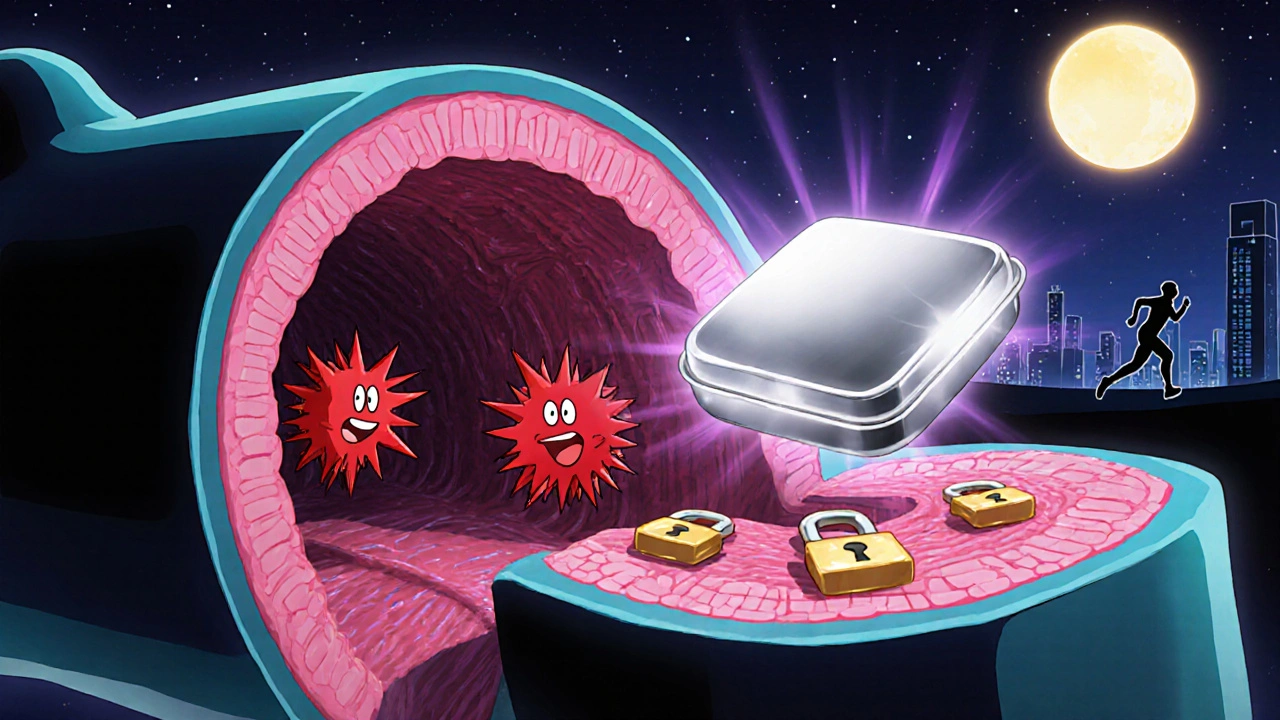Montelukast Dosage Calculator
Dosage Calculator
Recommended Dosage
When it comes to keeping asthma at bay, Montelukast often shows up in the conversation. In this review we’ll unpack what the drug does, who should consider it, how it stacks up against other preventers, and what safety signals you need to watch for.
What is Montelukast?
Montelukast is a leukotriene receptor antagonist (LTRA) that blocks the action of leukotriene D4, a chemical that provokes airway inflammation, mucus production, and bronchoconstriction. It was first approved by the FDA in 1998 under the brand name Singulair and has since become a staple in many step‑wise asthma plans.
How Montelukast Works in Asthma Prevention
Leukotrienes are produced by mast cells, eosinophils, and other immune cells during an allergic response. When they bind to cysteinyl‑leukotriene receptors on airway smooth muscle, they trigger three key events:
- Constriction of bronchi (making it harder to breathe)
- Increased vascular permeability (leading to swelling)
- Mucus hypersecretion (clogging the airways)
Montelukast binds competitively to these receptors, essentially putting a “do‑not‑enter” sign on the doors that leukotrienes try to use. The net effect is a reduction in chronic inflammation and fewer nighttime or exercise‑induced symptoms.
Approved Indications and Real‑World Use
Regulatory agencies (FDA, EMA, TGA) list Montelukast for:
- Maintenance treatment of asthma in patients 12 months of age and older.
- Prevention of exercise‑induced bronchoconstriction (EIB).
- Allergic rhinitis (as an adjunctive therapy).
Off‑label, clinicians sometimes prescribe it for chronic cough or for patients who struggle with inhaler technique, but those uses lack robust trial data.
Dosage Guidelines for Prevention
Dosage varies by age and weight. The most common regimen for asthma prevention is a once‑daily oral tablet:
- 12 months - 4 kg: 4 mg chewable tablet.
- 2-5 years: 4 mg chewable tablet.
- 6-14 years: 5 mg chewable tablet.
- 15 years and older: 10 mg tablet.
Take the dose in the evening to align with the nocturnal surge in leukotriene production. For exercise‑induced bronchoconstriction, a single 10 mg dose taken at least two hours before activity is recommended.

Efficacy: What the Evidence Says
Multiple randomized controlled trials (RCTs) and meta‑analyses have examined Montelukast’s preventive power. A 2023 Cochrane review found:
- A modest but statistically significant reduction in daytime symptom scores compared with placebo (mean difference -0.3 points on a 5‑point scale).
- Approximately 30 % fewer patients experienced nighttime awakenings.
- In children with mild persistent asthma, Montelukast reduced the need for rescue inhaler use by 25 %.
When paired with low‑dose inhaled corticosteroids (ICS), the combination showed additive benefits, especially for patients with allergic rhinitis comorbidity.
Safety Profile & Frequently Cited Side Effects
Overall, Montelukast is well‑tolerated. The most common adverse events (≥ 5 % incidence) are:
- Headache
- Abdominal pain
- Upper‑respiratory tract infection
- Rash
Serious concerns emerged from post‑marketing surveillance:
- Neuropsychiatric events (e.g., agitation, depression, suicidal thoughts). In 2021 the FDA issued a boxed warning urging clinicians to monitor mood changes, especially in children and adolescents.
- Allergic reactions ranging from mild urticaria to anaphylaxis (rare).
Renal or hepatic impairment does not require dose adjustment, but severe liver disease may warrant closer monitoring because Montelukast is metabolized primarily via CYP3A4 and CYP2C9.
Comparing Montelukast with Other Preventive Options
Below is a quick visual guide that pits Montelukast against two commonly used alternatives: inhaled corticosteroids (ICS) and the older LTRA zafirlukast.
| Attribute | Montelukast | Inhaled Corticosteroid (e.g., budesonide) | Zafirlukast |
|---|---|---|---|
| Class | Leukotriene receptor antagonist | Glucocorticoid | Leukotriene receptor antagonist |
| Route | Oral tablet | Inhaled aerosol | Oral tablet |
| Typical dose for adults | 10 mg once daily | 200-400 µg twice daily | 20 mg twice daily |
| Effect on nighttime symptoms | Modest improvement | Strong reduction | Similar to Montelukast |
| Key safety concern | Neuropsychiatric events | Oropharyngeal candidiasis, dysphonia | Liver enzyme elevation |
| Adherence advantage | Once‑daily pill, no inhaler technique required | Requires proper inhaler use | Twice‑daily pill, similar to Montelukast |
In short, Montelukast shines for patients who dislike inhalers or struggle with technique, while ICS remains the gold standard for reducing airway inflammation. Zafirlukast is rarely used now because of its hepatic monitoring burden.

Who Benefits Most from Montelukast?
Guidelines (GINA 2024) place Montelukast as a step‑2 add‑on for:
- Patients with mild persistent asthma who are well‑controlled on a low‑dose inhaled corticosteroid but still have nighttime symptoms.
- Children with allergic rhinitis and comorbid asthma - the single oral medication can address both conditions.
- Individuals who have exercise‑induced bronchoconstriction and need a pre‑exercise prophylactic.
- Patients who cannot reliably use inhalers due to physical limitations (e.g., severe arthritis).
Conversely, avoid Montelukast as monotherapy in severe asthma, in patients with a history of depression, or when a rapid‑onset bronchodilator is required.
Monitoring, Follow‑Up, and When to Switch
Set a baseline before starting therapy:
- Document asthma control status (e.g., Asthma Control Test score).
- Screen for baseline mood disturbances.
- Check liver enzymes if the patient has pre‑existing liver disease.
Follow‑up at 4-6 weeks:
- Re‑assess symptom frequency and rescue inhaler use.
- Ask targeted questions about mood, anxiety, or suicidal thoughts.
- If control is insufficient, consider adding a low‑dose inhaled corticosteroid or stepping up to combination inhaler therapy.
Long‑term, annual review is enough for stable patients without side effects. Immediate discontinuation is advised if severe neuropsychiatric symptoms emerge.
Practical Tips for Clinicians and Patients
- Advise patients to take the tablet in the evening to sync with the circadian surge of leukotrienes.
- Emphasize that the drug does not replace rescue inhalers - a short‑acting beta‑agonist should still be on hand.
- Provide a mood‑monitoring worksheet for adolescents; a simple “yes/no” check‑in can catch early warning signs.
- For children who can’t swallow tablets, the chewable 4 mg form is bioequivalent.
- Store the medication at room temperature, away from moisture and heat.
Key Takeaways
- Montelukast is a leukotriene receptor antagonist that helps prevent asthma symptoms, especially at night and during exercise.
- It works best as add‑on therapy or for patients who struggle with inhalers.
- Side effects are generally mild, but clinicians must monitor for mood changes.
- Compared with inhaled corticosteroids, it offers convenience at the cost of modest efficacy.
- Regular follow‑up and patient education are essential for safe, long‑term use.
Can Montelukast be used as a standalone treatment for moderate asthma?
For moderate persistent asthma, guidelines recommend inhaled corticosteroids as first‑line therapy. Montelukast alone usually does not provide sufficient anti‑inflammatory control, so it is best used as an add‑on or in patients who cannot use inhalers.
How quickly does Montelukast start working for exercise‑induced bronchoconstriction?
Peak plasma levels are reached within 3-4 hours. For EIB, a single 10 mg dose taken at least two hours before activity provides optimal protection.
Is it safe for pregnant women?
Pregnancy Category B suggests no evidence of risk in animal studies, but human data are limited. Discuss risks and benefits with your obstetrician before starting.
What should I do if my child develops mood changes while on Montelukast?
Stop the medication immediately and contact a healthcare professional. Consider alternative controller therapies like inhaled steroids or a different LTRA.
Can I take Montelukast with other asthma medications?
Yes, it is often combined with low‑dose inhaled corticosteroids, short‑acting bronchodilators, or biologics. No major pharmacokinetic interactions have been reported.


The reviewed article elucidates the pharmacodynamic profile of montelukast with commendable precision.
The drug targets cysteinyl‑leukotriene receptors, attenuating the cascade of bronchoconstrictive mediators.
The mechanistic exposition aligns with current GINA recommendations for step‑wise controller therapy.
Moreover, the discussion of leukotriene biosynthesis underscores the relevance of upstream enzymatic inhibition.
The dosage schema presented incorporates age‑weight stratifications that reflect pediatric pharmacokinetic variability.
The emphasis on evening administration is substantiated by circadian fluctuations in leukotriene production.
In the efficacy section, the meta‑analysis data are contextualized with absolute risk reduction metrics.
The reported 30 % decrease in nocturnal awakenings translates into a number needed to treat that is clinically meaningful.
However, the modest improvement in daytime symptom scores warrants cautious interpretation.
The safety narrative appropriately highlights neuropsychiatric signals that have precipitated recent FDA boxed warnings.
The juxtaposition of montelukast against inhaled corticosteroids is rendered with a balanced risk‑benefit matrix.
The table summarizing key attributes aids clinicians in therapeutic decision‑making.
Nevertheless, the omission of direct comparative head‑to‑head trials limits definitive conclusions regarding superiority.
The article also briefly mentions off‑label uses, yet it refrains from endorsing them without robust evidence.
From a pharmacovigilance perspective, the recommendation for mood‑monitoring worksheets is pragmatic.
Overall, the review integrates pathophysiological insight with pragmatic prescribing guidance.
Future research directions could explore pharmacogenomic predictors of response to optimize patient selection.